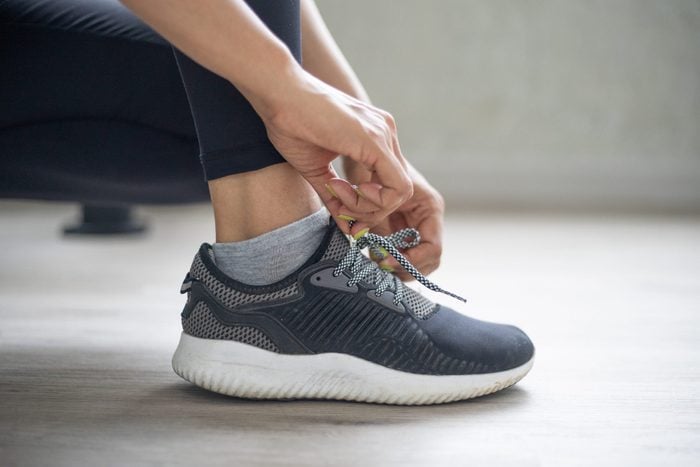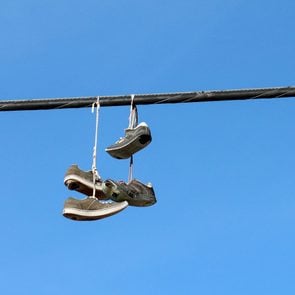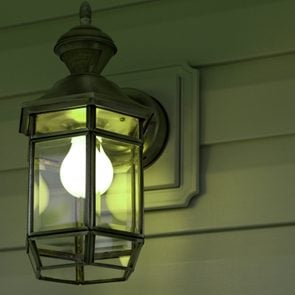This Is Why Your Sneakers Have an Extra Hole
Updated: Jan. 24, 2024

Ever noticed that extra shoelace hole on your sneakers? It's there for a reason, and you should be putting it to good use!
It’s been said of humans that our intelligence distinguishes us from the other animal species dwelling on our planet. Still, at times we can be slow on the uptake. Who knew, for example, that the tiny pocket on blue jeans is there for a very specific reason? Or that there’s actually a purpose for that extra shoelace hole in sneakers? Yep, that’s right—the extra hole that’s slightly diagonal from what most people think of as a sneaker’s uppermost hole isn’t just there for show. In fact, it has a genius purpose that will make your sneakers a lot more comfortable.
We came across this helpful tidbit from backpacker and outdoor adventurer Dan Becker on TikTok, where it’s racked up more than 24,000 views so far. It’s even gotten the seal of approval from foot doctors we spoke with. Here’s why you’ll kick yourself for not knowing this interesting fact sooner.
Get Reader’s Digest’s Read Up newsletter for more fascinating facts, cleaning, travel, tech and humor all week long.
Why do sneakers have that extra shoelace hole?
@danbeckeroutdoors What that extra lace hole on your shoes is for #b#blisterfixb#blisterh#hikingb#backpacking ♬ original sound – Dan
“It’s there to stop blisters from forming,” especially on the back of the heels, says Becker in his TikTok video. To execute what Becker calls a “heel lock,” simply push one end of the shoelace into the extra shoelace hole on the same side, and pull it most of the way through, leaving a small loop. Do the same on the other side. Then insert the end of each lace into the opposite loop, pull tight and, finally, tie your laces like you normally would. This loop-based lock will “lock that shoe around that heel … to stop it from moving around” against the back of the shoe, explains Becker. The upshot: no friction, no blisters!
Does this shoelace trick actually work?
Well, TikTok viewers are certainly impressed! “Brilliant! I had no idea,” commented one viewer, distinguishing Becker’s advice from the internet hacks that just don’t work. “Wish I’d known this 30 years ago,” wrote another.
Even celebrity foot surgeon Brad Schaeffer, DPM, who practices at Sole Podiatry NYC and stars in TLC’s My Feet Are Killing Me, seemed pleasantly surprised by Becker’s revelation. Ordinarily, Dr. Schaeffer ties the top laces in what he refers to as a “typical crisscross manner.” However, after watching the video, he plans to switch to this trick, noting that it works not only by keeping the heel in place but also by strapping down the top of the foot. “Friction is the main cause for blisters,” he explains. “And when you can support the foot by cupping the heel and holding the forefoot in place in this way, you can prevent this friction.”
Using the extra shoelace hole like this can also help prevent ankle sprains, which are often caused by shoes that don’t fit properly. “The heel lock is really great for lots of high-impact activities, like running and hiking, as well as activities involving lateral movement, like pickleball and basketball,” explains Zachery Barnett, DPM, a foot surgeon based in St. Petersburg, Florida.
The only time Dr. Barnett recommends not using the extra shoelace hole is when a sneaker is already tight-fitting. “If a shoe is small and you’re cranking it down with the heel lock,” he says, “it could put [too much] pressure and cause harm.” That situation, however, can be avoided by getting your feet measured before buying a new pair of sneakers.
Another way that extra shoelace hole comes in handy
Turns out that extra shoelace hole offers yet another benefit. Some parents are using the heel-lock method to teach their kids how to tie their own shoes, as another TikTok video illustrates. And consider it podiatrist-approved. “This is a super-easy way to teach your kids to tie their shoes,” Dr. Barnett tells Reader’s Digest, because it doesn’t involve holding on to loose loops and therefore requires less coordination. “And assuming a good fit, it’s a fine way to tie your shoes for the rest of your life.”
About the experts
- Brad Schaeffer, DPM, is a board-certified foot surgeon at Sole Podiatry NYC and the star of TLC’s My Feet Are Killing Me.
- Zachery Barnett, DPM, is a board-certified foot surgeon and an expert in trauma and sports medicine at Align Foot and Ankle in St. Petersburg, Florida. He has treated Olympians and professional athletes.



